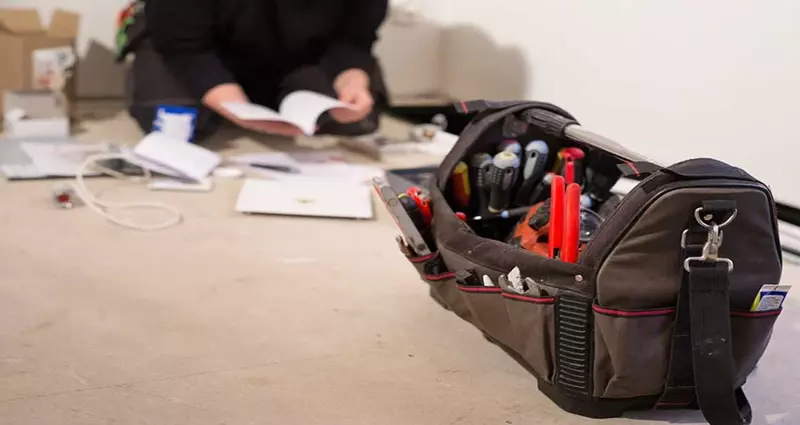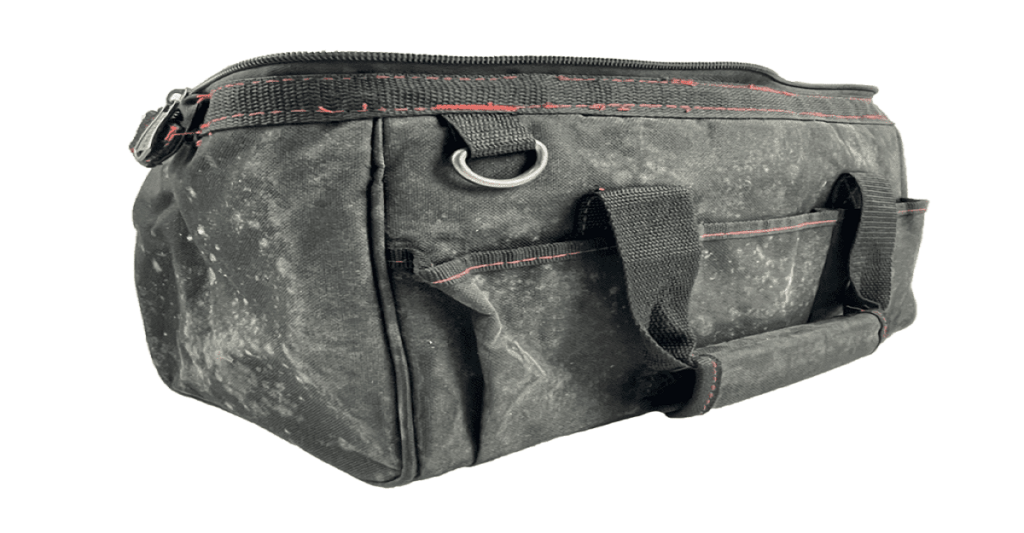Are you wondering about How to Maintain Your Tool Bag? Your search might end here. Tool bags are essential for carrying and organizing tools but can quickly become dirty and disorganized.
Proper cleaning and maintenance of your tool bag are crucial to ensure that your tools remain in good condition and are easily accessible when needed.
Clean And Maintain Your Tool Bag: Expert Tips
In this article, we will discuss the importance of cleaning and maintaining tool bags and provide a brief overview of the steps to clean and maintain them.
| Topic | Details |
|---|---|
| Cleaning Tool Bag: Steps | 1. Identify Material: Know the material (leather, canvas, nylon, polyester). 2. Prepare Supplies: Gather warm water, rags, soft brush, mild soap. 3. Empty Bag: Remove all tools and find stains. 4. Use Cleaning Solution: Choose a solution based on material (saddle soap for leather, fabric cleaner for canvas). 5. Clean Gently: Scrub stains and rinse the bag. 6. Dry Thoroughly: Let the bag dry completely before use. |
| Maintaining Tool Bag: Steps | 1. Organize: Group tools and use straps/pouches for secure storage. 2. Prevent Damage: Clean bag regularly and remove debris. 3. Lubricate Zippers: Use silicone spray or beeswax to maintain smooth zippers. 4. Protect from Heat: Keep the bag away from heat sources. |
Determining The Material Of Your Tool Bag
It is important to know the material of tool bag as it affects its durability, weight, water resistance, and cost. Different materials have advantages and disadvantages, so choosing the right one for your requirements is crucial.
Common materials used for tool bags include heavy-duty nylon, canvas, genuine leather, polyester, and vinyl PVC. To determine the material of your tool bag, you can check the label or tag that came with it.
If there is no label, you can examine the texture, color, and smell of the bag to identify the material.
For instance, leather has a distinct smell and texture, while nylon is lightweight and has a shiny appearance. Knowing the material of your tool bag will help you select an appropriate cleaning solution and avoid damaging the bag during cleaning.
Cleaning Tool Bag: Follow Simple Steps
To clean your tool bag, follow these simple steps:
- Identify Material: Determine the material of your tool bag, such as leather, canvas, nylon, or polyester, as the cleaning method varies for each material.
- Prepare Cleaning Tools And Supplies: Gather warm water, clean rags, a soft brush, and cleaning supplies like mild soap, laundry liquid, or a fabric cleaner.
- Empty The Tool Bag And Find Stains: Remove all tools and hardware from the bag. Look for any stains or debris that need to be cleaned.
- Use Appropriate Cleaning Solution: Select an appropriate cleaning solution or soap based on the material of your tool bag. For example, use mild soap like saddle soap for leather, and fabric cleaner for canvas or polyester.
- Gently Clean The Bag: Apply the cleaning solution to the bag and gently scrub any stains or dirt. Rinse the bag with clean water and wipe it down with a rag.
- Allow Bag To Dry Thoroughly: After cleaning, let the bag dry completely before using a finishing product, if necessary, to protect the material and prevent damage.
Different Cleaning Solutions For Different Materials
- Leather: Use mild soap like saddle soap or Castile soap.
- Canvas, Nylon, Polyester: Use a fabric cleaner, laundry liquid, or mild soap appropriate for the material.
Tips To Avoid Damaging Your Tool Bag During Cleaning
- Always test the cleaning solution on a small, hidden area of the bag first to ensure it doesn’t cause damage or discoloration.
- Gently scrub the bag to avoid causing any harm, especially for delicate materials like leather.
- Allow the bag to dry completely before using any finishing products to protect the material.
By following these steps and tips, you can effectively clean your tool bag without causing any damage and ensure it stays in good condition for a long time.
Maintaining Your Tool Bag For Maximum Efficiency

To maintain your tool bag effectively, follow these steps:
Organize Your Tool Bag
Organizing your tool bag is the best way to maintain tool bag. Group similar items together and place them in easily accessible compartments or pockets. This will help you quickly locate and retrieve the tools you need during your work. Consider using straps, elastic bands, or tool pouches to hold tools securely in place.
Prevent Damage To Your Tool Bag
Ensure that your tool bag is clean and free of debris or packaging materials. Wipe down the interior and exterior of the bag as necessary. Regularly clean your tool bag, clean the bottom of dirt and debris, clean zippers, and get rid of broken or unnecessary items.
Lubricate And Protect Your Tool Bag
Apply lubricant to hinges and zippers to prevent rust and ensure smooth operation. Use silicone spray, beeswax, or a zipper lubricant for this purpose. Store sharp tools in a way that they don’t poke into the zippers when the bag is closed.
Keep your bag away from extreme heat sources to avoid damaging the zippers.
How to Clean a Milwaukee Tool Bag?
To effectively clean a Milwaukee tool bag, follow these steps tailored to the material of your bag:
General Cleaning Steps
- Empty the Bag: Remove all tools and debris from the bag to start with a clean slate.
- Spot Clean: For any visible stains, use a mild detergent and a soft brush to spot-clean those areas.
Cleaning by Material
You can maintain your Milwaukee tool bag’s appearance and functionality over time with the following tips:
Canvas and Nylon Bags
- Machine Washing: Most canvas and nylon tool bags can be machine washed. Use a gentle cycle and consider placing the bag in a washing bag for added protection.
- Hand Washing: Alternatively, wash by hand in lukewarm water with mild detergent. Gently scrub heavily soiled areas, then rinse thoroughly.
- Drying: Allow the bag to air dry completely, avoiding direct heat sources.
Leather Bags
- Wipe Down: Use a damp cloth to wipe the surface. Do not submerge leather bags in water.
- Conditioning: Regularly apply a leather conditioner to maintain suppleness and prevent cracking.
Additional Tips
- Avoid Harsh Chemicals: Do not use bleach or cleaners with ammonia, as these can damage the fabric.
- Drying Techniques: For quicker drying, place nylon or canvas bags in front of a fan or use a blow dryer on low. Leather should be dried away from direct sunlight.
How Do You Get Mold Out Of a Tool Bag?
To remove mold from a tool bag, follow these steps:
- Empty the Bag: Remove all tools and debris from the bag.
- Brush Off Mold: Use a soft brush to gently scrub off any visible mold.
- Prepare Cleaning Solution: Mix warm water with mild detergent or vinegar. For tougher mold, a diluted bleach solution (1 cup bleach to 1 gallon of water) can be used.
- Soak and Scrub: Submerge the bag in the solution or apply it with a sponge, scrubbing the affected areas thoroughly.
- Rinse: Rinse the bag with clean water to remove any cleaning solution.
- Dry Completely: Hang the bag outside in the sun to dry completely, as sunlight helps kill remaining spores.
To prevent future mold growth, store the bag in a dry environment and consider using silica gel packets to absorb moisture.
Importance Of Investing In High-Quality Tools
Investing in high-quality tools is crucial for several reasons. While high-quality tools may cost more upfront, they offer the following benefits:
- Durability: High-quality tools are made from sturdy materials and are built to last, reducing the need for frequent replacements.
- Performance: They often perform better and are more reliable, ultimately saving time and money in the long run.
- Safety: High-quality tools are designed with safety in mind, reducing the risk of accidents and injuries during use.
- Efficiency: They can improve efficiency and productivity, making tasks easier and more enjoyable.
The Final Words
Cleaning and maintaining your tool bag is essential for ensuring the longevity and functionality of your tools and the tool bag itself. By learning how to clean and maintain your tool bag, you can keep your tools in optimal condition for any job.
Remember to regularly clean your bag, inspect its contents, and empty it of debris and tools. This will help prolong the life of your tool bag and ensure that your tools remain in good condition for years to come.
You may also like How To Set Up A Tool Bag.
FAQs (Frequently Asked Questions)
How to clean canvas tool bags?
To clean canvas tool bags, use warm water, a mild detergent, and a soft-bristle brush to scrub in a circular motion. Air-dry the bag completely before putting your tools back in.
Can you wash a Milwaukee tool bag?
Yes, you can wash a Milwaukee tool bag. Determine the material of the bag and use an appropriate cleaning solution or soap according to the material. Rinse the bag with clean water after applying the cleaning solution and wipe it down with a rag.
How to clean Occidental leather bags?
For leather tool bags, use a mild soap like saddle soap or Castile soap with a soft brush. Rinse the bag with clean water and wipe it down with a rag.
How often should I clean my tool bag?
It is a good practice to clean your tool bag after each use, especially if it has come into contact with dirt, dust, or any other contaminants. Regular cleaning helps maintain the condition of your tools and extends the life of your bag.
Can you wash a Dewalt Tool bag?
Yes, you can wash a Dewalt tool bag, especially if it is made of durable materials like canvas or nylon. For best results, empty the bag, spot clean stains with mild detergent, and machine wash on a gentle cycle or hand wash in warm water. Always air dry completely before use.








